Research Achievement
2021
Nature 599, 576-581 (2021)
최근 위상학적인 전자상태를 가지는 고체 물질에 대한 연구가 심화되면서, 자성과 위상학적 전자상태를 동시에 갖는 물질인 위상 자성체에 대한 연구 또한 활발히 진행되고 있다. 본 연구팀은 자성을 띠는 반도체 물질에서 위상학적인 전자상태에 의한 초거대 각자기저항 현상을 최초로 발견했다. 연구진은 위상학적 전자상태가 전도띠 (conduction band) 또는 원자가띠 (valence band)에 존재하는 물질인 자성 위상 반도체의 개념을 제안했고, 이러한 물질에서는 스핀 방향을 외부자기장으로 조절하면 전류를 흐르거나 흐르지 못하게 조절할 수 있을 것으로 예상했다. 기존의 자성체에서 스핀의 방향을 바꾸었을 때 전류의 흐름이 일부 조절되는경우는 있지만, 전류를 완전히 흐르거나 흐르지 못하게 조절하는 경우는 보고된 바가 없었다.
연구진은 Mn3Si2Te6라는 물질에서 스핀 방향에 따라 위상학적 전자상태의 변화가 나타날 수 있음을 예측하였고, 합성된 단결정의 전도성이 자기장의 방향에 따라 10억 배 정도 급격하게 변화하는 것을 발견하였다. 또한 이러한 초거대 각자기저항 현상이 스핀 방향에 따라 유도되는 부도체-금속 상전이에 기인한다는 점을 이론적으로 규명하고, 자기장 방향에 따른 광학 특성 측정을 통해 이를 직접적으로 관측하였다. 이번에 발견된 자성 위상반도체의 초거대 각자기저항 현상은 향후 고도로 예민한 자기장 방향 감지나 스핀 정보의 관측에 활용될 수 있을 것으로 기대된다.
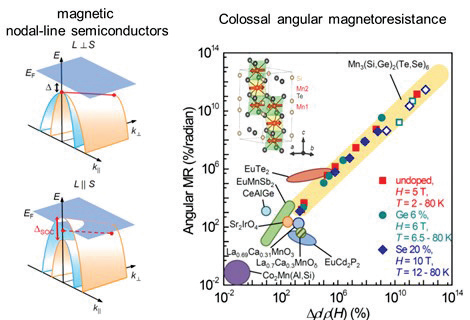
Figure .(left panel) Schematic illustration of insulator-to-metal transition by lifting the nodal-line degeneracy with spin rotation. (right panel) Angular magnetoresistance and magnetoresistance for various magnets.
Topological magnets, where both magnetism and topological electronic states coexist, have been intensively studied these days because of their intriguing physical properties. A research team led by Prof. Jun Sung Kim discovered a new magneto-transport phenomenon, named as colossal angular magnetoresistance (CAMR), in a magnetic van der Waals semiconductor with topological electronic states. The research team has proposed the concept of magnetic nodal-line semiconductors, which possess the nodal-line band degeneracy in conduction or valence bands, and predicted that electrical current can be extremely sensitive to spin orientation leading to CAMR. As a model system, the research team proposed a van der Walls ferrimagnet Mn3Si2Te6 and experimentally showed a huge variation of magnetoresistance in high-quality single crystals under rotating magnetic field. The observed billion times variation of magnetoresistance has never been measurements and terahertz absorption spectroscopy. This newly discovered nodal-line magnetic semiconductor with CAMR may offer a new material platform for an extremely sensitive vector magnetic sensing or efficient electrical readout of spin information.
Nature Physics 17, 1024-1030 (2021)
엑시톤 준입자들은 레이저 등의 주사에 의해 여기되어 발견되는 반도체 물질의 기본적은 여기 준입자로서 다양한 광소자와 새로운 양자정보소자의 기본 요소로서 널리 연구되어 오고 있다. 하지만 그 수명이 매우 짧고 저온에서만 관측되어 소자활용에 제약이 있었다. 다른 한편 반금속물질 등에서는 특수한 조건하에 자발적으로 많은 엑시톤들의 형성될 수 있음이 오래전부터 이론적으로 예측되어 왔으나, 이러한 상태(엑시톤절연체)를 지니는 물질이 분명하게 발견되지 않았다. 본 연구에서는 최근 자발적 엑시톤 상태가 발현될 것으로 예측된 Ta2NiSe5 결정에 대한 편광의존 각분해광전자분광실험을 실시하여 실온보다 높은 온도에서 자발적으로 형성된 엑시톤으로부터의 광전자방출을 직접 측정하는데 성공하였다. 이를 통해 이 물질의 엑시톤절연체임이 확실해졌으며, 자발적으로 형성된 엑시톤의 크기 등의 정보를 추출할 수 있었다. 본 연구는 오랫동안 증명되지 않았던 엑시톤절연체 가설을 증명함과 동시에 엑시톤을 활용한 실온에서의 다양한 첨단소자의 가능성을 크게 높였다고 할 수 있다.
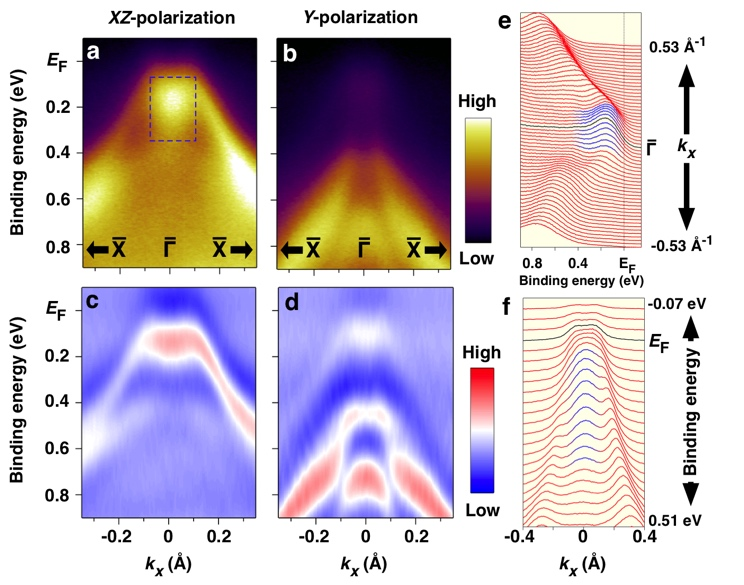
Figure. Polarization-dependent angle-resolved photoelectron spectroscopy spectra for Ta2NiSe5, which show the strong non-band origin spectral feature at Brillouin zone center due to spontaneously formed excitons.
Excitons, quasiparticles of electrons and holes bound by Coulombic attraction, are created transiently by light and play an important role in optoelectronics, photovoltaics and photosynthesis. While they are also predicted to form spontaneously in a small gap semiconductor or a semimetal, leading to a Bose-Einstein condensate at low temperature, their material realization has been elusive without any direct evidence. Here we utilize temperature- and polarization (symmetry)-dependent angle-resolved photoemission spectroscopy (ARPES) to investigate the formation and the symmetry of the quasiparticles in a major EI candidate Ta2NiSe5 (TNS) across its anomalous phase transition. Our experimental results below the transition temperature (Tc = 327 K) confirm the hybridization between the valence and the conduction band orbitals near the Fermi level. The origin of this interband hybridization has been debated with excitonic or structural origins. In contrast, the band structure above Tc shows no clear sign of such band hybridization, ruling out a substantial structural effect, but the band gap persists. Moreover, we identify the emergence of a characteristic photoelectron signal, which can only be explained by the direct photoemission from excitons38. This is the first direct signature of the spontaneously formed excitons, the so-called ‘preformed excitons’ preceding the emergence of BEC at a lower temperature39-44. The present results, therefore, guarantee an excitonic insulator transition inTa2NiSe5 at low temperature without any ambiguity related with the structural transition occurring at Tc39,44.
NATURE COMMUNICATIONS 12, 1969 (2021)
엑시톤 절연체는 전자-홀 간의 상호작용에 기인하는 새로운 양자물질상으로 반 세기 전에 예측되었지만 실제 물질에서의 실험적 증거는 현재까지도 불분명하다. 대표적인 후보 물질로 Ta2NiSe5를 예로 들 수 있는데, 일반적으로 전자 상전이는 구조적 상전이를 수반하기 때문에, 엑시톤 절연체가 아닌 일반적인 밴드 절연체라는 주장이 지속적으로 제기되고 있으며, 엑시톤 불안정성이 상전이의 직접적인 요인임을 밝혀진 바는 없다. 본 연구에서는 편광 분해 라만 분광법을 활용하여 Ta2NiSe5의 상전이가 구조적 요인이 아닌 전자적 요인에서 비롯됨을 밝히고, 해당 물질에서 엑시톤 절연체의 가능성을 확인하는 결정적인 단서를 관측하였다. 기존 연구에서는 발견하지 못했던 저에너지의 새로운 전자 라만 산란 신호를 관측하였다. 또한 추가적인 분석을 통해 해당 신호가 전자-양공 쌍과 같은 대칭성을 지닌다는 사실과, 전기적 라만 감수율이 상전이 온도 위에서 온도의 역수에 비례하는 퀴리-바이스 현상을 보이는 것을 확인하였다. 이를 통해Ta2NiSe5의 상전이가 전자적 불안정성에 기인함을 직접적으로 밝혀냈으며, 구조적 상전이와 밀접한 관련이 있는 포논이 상전이 온도에서 응축하지 않는다는 점을 토대로, 상전이 현상의 원동력에서 구조적 요인을 배제하였다.
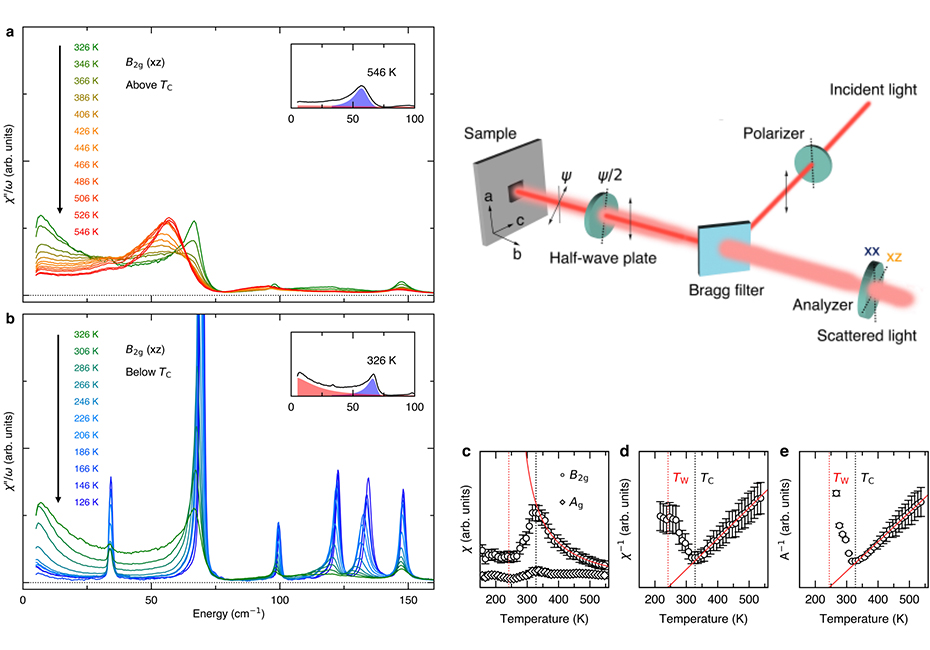
Figure. Raman conductivity (a)above and (b) below TC.(c) Static susceptibility exhibiting the Curie-Weiss behavior. (d) The inverse of the static susceptibility. (e) The inverse amplitude of the quasi-elastic scattering
Exciton insulator is an elusive phase of matter predicted more than half a century ago that arises due to the strong interaction between electrons and holes. However, experimental evidence for realization of an exciton insulator in a real material is still unclear. Ta2NiSe5 is a representative candidate material. In general, an electronic phase transition accompanies a structural one. As a result, the claim that Ta2NiSe5 is a band insulator rather than an exciton insulator has continuously been raised, and direct evidence that electronic instability drives the phase transition has been lacking. In this research, we used polarization-resolved Raman spectroscopy to reveal that the phase transition inTa2NiSe5 is driven by an electronic instability, providing the key missing link to confirm the possibility of an exciton insulator in the material. A low-energy Raman scattering signal was observed, which was not found in previous studies. In addition, it was confirmed that the signal has the same symmetry as the electron-hole pair, and that the electrical Raman susceptibility exhibits a Curie-Weiss behavior proportional to the reciprocal of the temperature above the phase transition temperature. Our observation directly reveals that the phase transition of Ta2NiSe5 is due to electronic instability, and based on that the phonon mode that is responsible for the structural phase transition does not condense at the phase transition temperature, the structure driven phase transition scenario is ruled out.
Nature Nanotechnology 16,1092-1098 (2021)
본 연구단의 재료그룹은 반데르발스 물질의 고유한 비등방성으로부터 기인한 다차원적 계면에서 나타나는 새로운 물리적 현상을 재료 플랫폼화 하는 것에 집중하고 있다. 본 연구에서는 두 가지 이상의 서로 다른 원자층 반도체의 반데르발스 에피택시 성장법을 개발했다. 기존, 층과 층 사이에 약한 공유 결합으로 인해 박막이 균일하게 쌓아지지 않아 2차원 반도체 물질의 복합적 접합을 증착하는 기술은 불가능했다. 이번 연구에서는 핵생성과 성장 동역학을 조절한 금속유기화학증착법을 이용하여 서로 다른 원자층 반도체가 9층까지 반복되는 반도체 초격자 구조를 처음으로 구현했다. 개발한 2차원 반도체 초격자 구조 성장법을 이용하면 원자층 수준에서 원자 종류와 주기의 인위적 제어가 가능하다. 이는 새로운 인공 물질을 자유자재로 디자인함으로써, 다양한 전자 구조를 갖는 저차원 전자계 구현으로 이어질 수 있다.
나아가 밸리(valley)라는 전하의 새로운 자유도가 반데르발스 초격자 내 저장됨을 확인했다. 밸리는 2차원 반도체 초격자 구조에서 양자 정보의 매개체로 이용될 수 있는데, 2-유형 밴드 정렬을 갖는 초격자의 반복 횟수와 저장되는 밸리 편광된 전하의 정보가 비례하고, 이 정보가 남아 있음을 초고속분광법으로 확인했다. 이로써 새로운 반도체 초격자가 양자 정보 연산이 가능한 양자 반도체 플랫폼에 활용될 수 있을 것으로 기대된다. 본 연구는 반데르발스 반도체 초격자 구조를 최초로 구현하여 현대 전자 소자 또는 광소자 반도체 기술에 새로운 방향성을 제시한 것이다 (Nature Nanotechnology 2021).
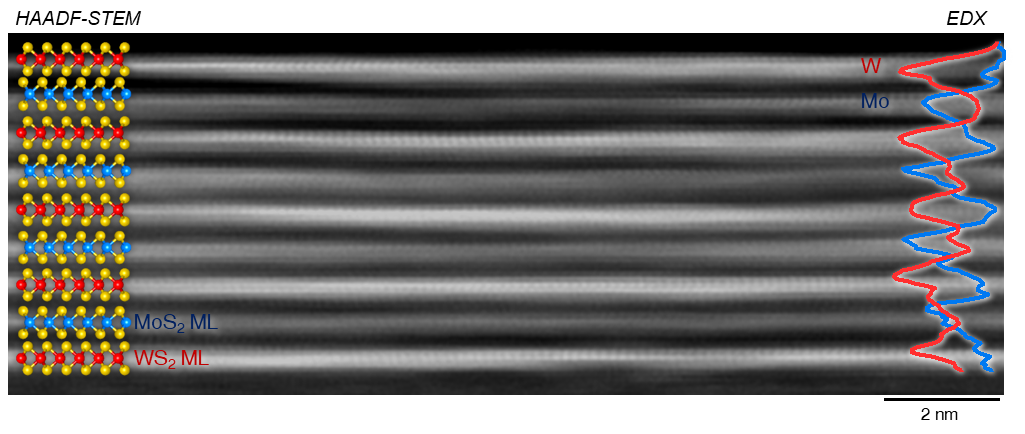
Figure. ML-by-ML vdW heteroepitaxy of MoS2/WS2 superlattices (Nature Nanotechnology 2021).
The CALDES material group focuses on developing the material platforms for new physical phenomena from low-dimensional heterointerfaces, resulting from the intrinsic anisotropy of van der Waals (vdW) materials. In this study, we reported the atomic layer-by-layer epitaxial growth of vdW superlattices with programmable stacking periodicities more than two kinds of dissimilar vdW semiconductors, transition-metal dichalcogenides (TMDCs). Using kinetics-controlled vdW epitaxy in the near-equilibrium limit by metal–organic chemical vapour depositions, we firstly demonstrated precise ML-by-ML stacking, free of interlayer atomic mixing, which resulted in tunable two-dimensional vdW electronic systems.
Furthermore, we confirmed that valley degree of freedom, one of the most distinctive electronic features in vdW ML semiconductors, can be stored in coherent two-dimensional vdW heterointerfaces. By exploiting the series of type-II band alignments, we demonstrated valley-polarized carrier excitations which scale with the stack numbers n in our (MoS2/WS2)n SLs on optical excitations. Designer vdW SLs by epitaxy could serve as scalable platforms for a new type of QW states with distinct vdW interfaces. This study presents that vdW semiconductor superlattice structure paves the way for a new direction in modern electronics, photonics and display technology. (Nature Nanotechnology 2021).
대표적인 이차원 모트절연체로 오랫동안 알려졌던 1T-TaS2 결정은 최근 본 연구단의 연구를 포함한 몇몇 연구에서 층간상호작용에 의한 spin-singlet dimer가 형성되어 일반적인 절연체로 되어있을 가능성이 높게 예측되었다. 이러한 새로운 결과들은 van der Waals 결정에서의 그동안 크게 주목받지 못했던 층간상호작용의 중요성을 말해주는 동시에 모트절연체를 실험적으로 정확하게 보여주는 지표가 없다는 오래된 사실을 각인시켜주고 있다. 본 연구에서는 모트절연체를 밴드갭의 이론적인 해석을 통해서가 아니라 실험적으로 분명하게 보여줄 수 있는 방법을 고안하고자 하였다. 특히, Mottness의 핵심이 되는 half-filled localized electron의 존재를 실험적으로 증명하고자 하였는데, 이는 전자 하나를 가지는 알칼리금속 원자를 흡착시켜 half-filled localized electron과 직접적으로 상호작용하도록 하는 것이었다. 그 결과 모트절연체의 경우는 half-filled localized electron이 알칼리 전자와 직접적인 결합을 하게되고 이는 일반적인 절연체의 경우 알칼리 흡착원자의 전자가 국소적인 결합에 참여하지 못하고 bulk doping을 하게되는 거동과 완전히 대비되는 특성을 보이게 됨을 분광학적으로 증명하였다. 이를 통하여 이론적인 해석없이 실험적인 방법으로 모트절연체를 특정할 수 있는 방법이 최초로 개발되었다고 할 수 있다. 해당 연구는 Phys. Rev. Lett. 게재되었으며 Physics Today등에 highlight로 소개되었다.
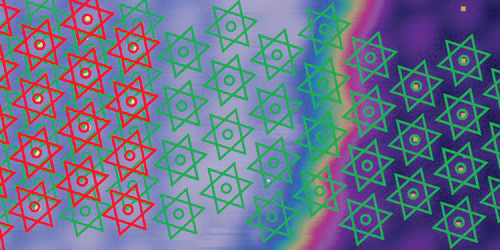
Figure. STM image of alkali adsorbates on 1T-TaS2
In an electronic system with various interactions intertwined, revealing the origin of its many-body ground state is challenging and a direct experi-mental way to verify the correlated nature of an insulator has been lacking. Here we demonstrate a way to unambiguously distinguish a paradig matic correlated insulator, a Mott insulator, from a trivial band insulator from their distinct chemical behavior for a surface adsorbate. The insulating phase in a layered material 1T-TaS2, where the electron-electron, electron-phonon, spin-spin, and interlayer interaction are all active, has been suggested as a spin-frustrated Mott insulator or a spin-singlet trivial insulator. We start from the observation of di erent sizes of spectral gaps on di erent surface terminations and show that potassium adatoms on these two surface layers behave in totally di erent ways. This can be straightforwardly understood from distinct properties of a Mott and a band insulators due to the fundamental di erence of a half and a fully filled orbital involved respectively. This work not only solves an outstanding problem in this particularly interesting material but also provides a simple touchstone to identify the correlated ground state of electrons experimentally.
Nature Communications 12, 3157 (2021)
극저온에서 전자의 농도나 외부 압력이 바뀌면서, 원래 나타나던 전자의 정렬 상태가 사라지거나 다른 상태로 변하는 현상이 나타나는데 이를 양자 상전이 현상이라고 한다. 지금까지는 양자 상전이 현상이 일어날 때 보통의 초전도체와 다른, 비고전적인 초전도 현상이 자주 발견됐다. 이때 비고전적인 초전도 현상을 유도하는 중요한 요인 중 하나는 전하정렬 상태가 사라지면서 나타나는 양자요동이라고 여겨졌다. 하지만 아직도 전하정렬 상태와 초전도 상태가 어떤 관계를 가지는지 명확히 밝혀지지 않았다.
본 연구에서는 전하의 공간적인 분포가 선형적인 패턴으로 정렬된 상태를 가지고 있는 이리듐-다이텔루라이드(이하 IrTe2)의 두께를 수십 나노미터 수준으로 박리하여, 2차원 초전도성을 유도하고, 이 초전도 현상이 전하정렬상태와 공존한다는 것을 밝혀냈다. 연구진은 전하의 정렬상태와 초전도 상태 간의 관계를 연구하기 위해 전하 정렬상태를 가지고 있는 물질 중에서도 약한 반데르발스 결합으로 이루어진 층상구조 물질에 주목해왔다. 층 사이가 약한 반데르발스 결합으로 이뤄진 점을 이용하여 물질의 두께를 얇게 함으로써 전하정렬 상태를 조절하였다. 이 경우 구조나 정렬의 결함을 야기하지 않고 물질의 고유 상태를 유지하며 전자 간의 상호작용만 조절할 수 있다는 장점이 있다. 연구진은 저온에서 전하정렬 상태가 나타나는 대표적인 반데르발스 물질인 IrTe2의 두께를 다양하게 조절하면서 전하정렬 상태와 초전도 현상을 체계적으로 조사했다. 이를 통해 수십 나노미터 두께의 IrTe2 박막에서 전하정렬 상태가 여전히 유지되면서 동시에 초전도 현상이 나타난다는 점을 확인했다.
이런 결과는 전하정렬이 약화될 때 나타나는 양자요동으로 초전도 상태가 유도되는 기존의 보고와는 상반되는 결과이다. 특히 이번 연구는 물질의 두께를 조절함으로써 전하정렬의 소멸과 그로 인한 양자요동이 없어도 초전도 현상을 유도할 수 있다는 점을 확인한 첫 사례이다. 향후 두께 조절을 통해 양자 상전이, 그리고 전하정렬 상태와 초전도 상태의 관계를 밝히는 데 중요한 기여를 할 것으로 기대된다.
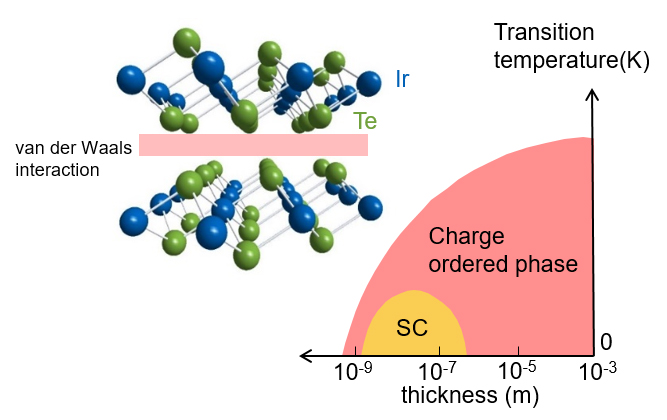
Figure 1. (Left) Crystal structure of IrTe2 with van der Waals gap. (Right) Thickness dependent phase diagram showing a superconducting dome inside the electronic ordered phase.
At ultra-low temperature, upon chemical doping or pressure, the electronic ordered phases are commonly driven into a superconducting phase, resulting in a characteristic dome-shaped phase diagram. This common feature, found in many unconventional superconductors, has supported a prevalent scenario in which fluctuations or partial melting of a parent order are essential for inducing or enhancing superconductivity. Understanding the complex interplay between charge ordering and superconducting instabilities is a long standing issue.
In this study, we found in IrTe2 nanoflakes of which the superconducting dome is identified well inside the parent stripe charge ordering phase in the thickness-dependent phase diagram. Utilising the weak van der Waals (vdW) coupling between layers, we thinned down the IrTe2 single crystals to atomic length scale, comparable with the coherence lengths of their various electronic orders, to tune the stripe order without introducing quenched disorders. The coexisting stripe charge order in IrTe2 nanoflakes significantly increases the out-of-plane coherence length and the coupling strength of superconductivity, in contrast to the doped bulk IrTe2. These findings clarify that the inherent instabilities of the parent stripe phase are sufficient to induce superconductivity in IrTe2 without its complete or partial melting.
This study presents the first example revealing the collaborative role of parent order to the superconductivity without fluctuations or partial melting of the parent order. Our study highlights the thickness control as an effective means to unveil intrinsic phase diagrams of correlated van der Waals materials.
Nature communications 12, 2844 (2021)
2차원 자석은 차세대 정보소자 후보인 스핀정보소자 구현에 필요한 핵심 소재 중 하나다. 전자 소자가 0과 1 정보를 담은 수많은 트랜지스터로 이루어지듯, 스핀 정보소자에서 스핀 ↑과 ↓정보의 입·출력을 위해서는 다양한 자성상태를 갖는 자석을 서로 접합시켜야 한다. 따라서 2차원 자석에서 자성상태를 조절하는 것은 매우 중요한 과제였다. 그러나 2차원 자석 후보 물질이 드물고, 매우 낮은 온도에서만 자성이 나타나 적합한 소재를 확보하기 어려웠다.
본 연구에서는 4가지 서로 다른 자성 상태를 조절할 수 있는 2차원 자석을 합성해냈다. 당 연구팀은 지난 해 고온에서도 자성이 유지되고 전기가 통하는 2차원 층상 물질인 철-저마늄-다이텔루라이드(이하 Fe4GeTe2)의 설계 및 합성에 성공한 바 있다. 나아가 연구팀은 층 사이 자성결합 세기에 따라 Fe4GeTe2의 자성상태가 민감하게 변하는 데 착안하여, 층간 결합 세기를 조절하기 위해 Fe4GeTe2의 일부 철 원자를 다른 원자로 치환하는 실험을 계획했다. 철 원자와 비슷한 망간, 코발트, 갈륨, 루테늄 원자를 후보로 하여, 각 원자로 치환했을 때 자성상태를 계산하고 실제 합성과 측정 실험을 수행했다. 그 결과 철을 코발트로 치환한 철-코발트-저마늄-다이텔루라이드(이하 Fe4-xCoxGeTe2)가 4가지 자성상태를 가질 수 있음을 발견했다. Fe4-xCoxGeTe2는 코발트 원자 농도에 따라 다른 자성상태를 갖는다. 이때 자성의 정렬에 따라 강자성과 반강자성, 방향에 따라 수직 이방성과 수평 이방성이 조합되는 4가지 자성상태를 가질 수 있었다.
이번에 발견한 물질은 코발트 농도 뿐 아니라 박막의 층수를 조절해 자성 상태를 조절할 수 있다. 4가지 자성상태는 특정 온도 영역에서 나타나는데, 층수에 따라 그 영역이 달라진다. 따라서 층수를 변경하면 같은 온도라도 다른 자성 상태를 갖게 된다. 이는 자성상태를 조성과 두께를 이용해 자유자재로 조절할 수 있는 최초의 2차원 자석을 합성한 성과로, 향후 서로 다른 자성상태의 층을 결합하면 스핀정보 처리에 유용한 특성을 유도할 수 있을 것으로 기대된다.
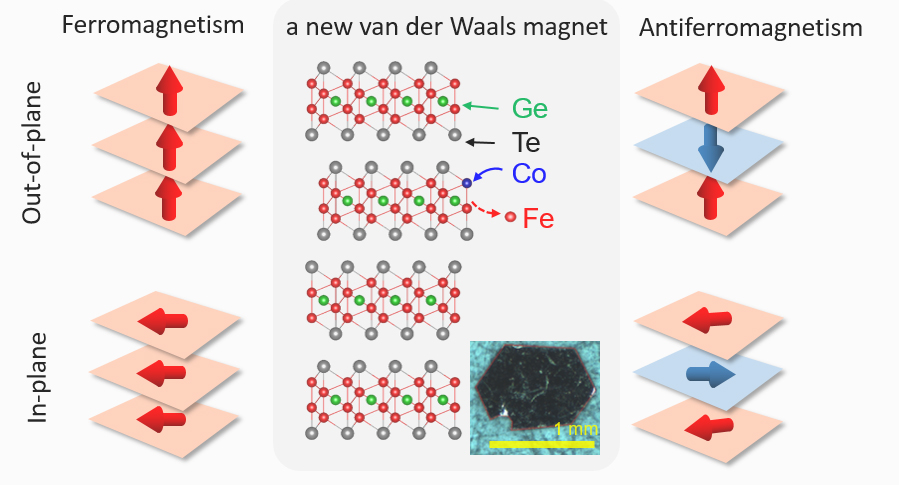
Figure 1. (Center) Crystal structure of a newly-synthesized van der Waals magnet (Fe,Co)4GeTe2 and the optical image of the single crystal. (Left and Right) Four different magnetic states with the ferromagnetic/antiferromagnetic spin configurations and the out-of-plane/in-plane spin orientations.
Discovery of two dimensional (2D) magnets, showing intrinsic ferromagnetic (FM) or antiferromagnetic (AFM) orders, has accelerated development of novel 2D spintronics, in which all the key components are made of van der Waals (vdW) materials and their heterostructures. High-performing and energy-efficient spin functionalities have been proposed, often relying on current-driven manipulation and detection of the spin states. In this regard, metallic vdW magnets are expected to have several advantages over the widely-studied insulating counterparts, but have not been much explored due to the lack of suitable materials.
Here, we report tunable itinerant ferro- and antiferromagnetism in Co-doped Fe4GeTe2 utilizing the vdW interlayer coupling, extremely sensitive to the material composition. This leads to high TN antiferromagnetism of TN ~ 226 K in a bulk and ~ 210 K in 8 nm-thick nanoflakes, together with tunable magnetic anisotropy. The resulting spin configurations and orientations are sensitively controlled by doping, magnetic field, and thickness, which are effectively read out by electrical conduction. These findings manifest strong merits of metallic vdW magnets as an active component of vdW spintronic applications.
 Center for Artificial Low
Center for Artificial Low